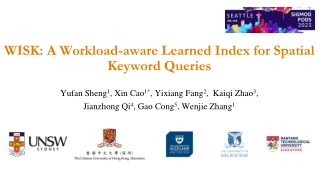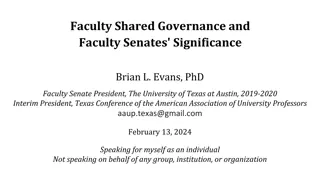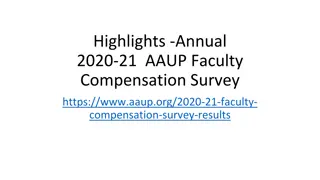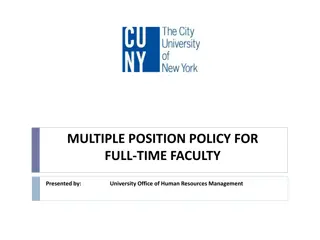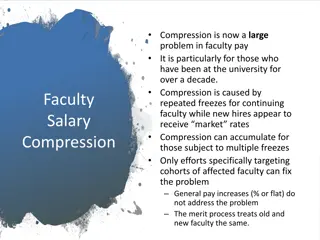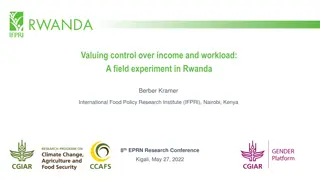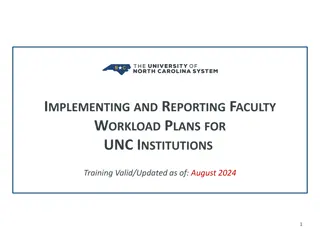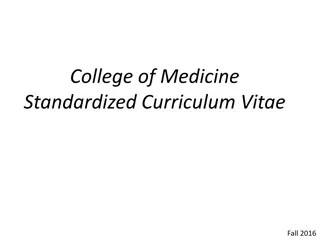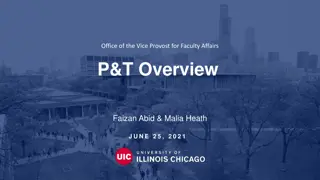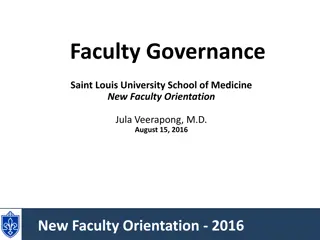University Faculty Workload Policy 2020
The University's 2020 policy focuses on establishing clear faculty workload requirements to enhance student learning opportunities, aligning teaching loads with comparable institutions, adjusting loads based on scholarly productivity, and considering service levels. This comprehensive policy revision aims to streamline workload expectations and ensure faculty engagement.
Download Presentation

Please find below an Image/Link to download the presentation.
The content on the website is provided AS IS for your information and personal use only. It may not be sold, licensed, or shared on other websites without obtaining consent from the author.If you encounter any issues during the download, it is possible that the publisher has removed the file from their server.
You are allowed to download the files provided on this website for personal or commercial use, subject to the condition that they are used lawfully. All files are the property of their respective owners.
The content on the website is provided AS IS for your information and personal use only. It may not be sold, licensed, or shared on other websites without obtaining consent from the author.
E N D
Presentation Transcript
University Policy 2020 Faculty Workload
Background on Policy Revision Faculty workload requirements must be set forth in a faculty workload policy, providing clarity and transparency. WSU students should have sufficient opportunity to learn from our highly qualified professorial and instructional faculty throughout their university experience. The former MOUs on Workload, dating from 2011-14, are no longer in effect.
Goals of the Policy To bring WSU faculty teaching load expectations in line with those at most other Ohio public R-2 universities To ensure that all WSU faculty avail themselves of significant service opportunities in support of the principle of shared governance To provide consistency and clarity to faculty and management in calculating the impact of faculty service, research, and other assigned or approved effort on teaching assignments
Comparative Faculty Teaching Loads Institution Tenured and Tenure Eligible Non-tenure Eligible ( Teaching faculty) University of Akron Standard: 24 c.h. per year Not specified University of Toledo Maximum: 24 c.h. per year Maximum: 30 c.h. per year Kent State University Standard: 24 c.h. per year Standard: 30 c.h. per year Youngstown State University Shawnee State University Central State University Cleveland State University Standard: 24 c.h. per year Standard: 30 c.h. per year WSU (new policy) WSU (former practice) Standard: 24 c.h. per year Standard: 15-16 c.h. per year Standard: 30 c.h. per year Standard: 21-24 c.h. per year
TET teaching loads may be adjusted due to Scholarly productivity/non-productivity Reasonable scholarly productivity over a 3-year period = - 3 c.h. per semester Acceptable scholarly productivity over a 3-year period = - 3 c.h. per year Less than acceptable scholarly productivity over a 3- year period = + 3 c.h. per year A probationary TET will be assumed to have been reasonably productive for probationary years 1-2 and will have a base teaching load of nine (9) credit hours per semester in years 1 and 2.
TET and NTE teaching loads may be adjusted due to a significant level of service Level of anticipated and documented service meets criteria for routine service plus exceeds the criteria for significant service demonstrating active engagement and productive leadership (approx. 7-9 hours per week of effort) = - up to 3 c.h. per year for TET, -up to 6 c.h. per year for NTE. Level of anticipated and documented service meets contractual obligations = no adjustment. Level of anticipated and documented service beyond routine service is negligible = + 3 c.h. per year
FALL 12 SPRING 12 1 Begin each academic year TET with a base teaching load of twelve (12) credit hours per semester ____Faculty member has been reasonably productive in scholarship over prior three (3) years. (Faculty member has produced at least 50% of the requirements for promotion to Associate Professor in that department over previous three years (Verify and list relevant production below). Subtract up to three (3) credit hours from each semester. OR ____ Faculty member has been acceptably productive in scholarship over the prior three (3) years. (Faculty member has produced at least 25% of the requirements for promotion to Associate Professor in that department over the previous three years (Verify and list relevant production below). Subtract up to three (3) credit hours from one semester only. OR _____Faculty member has not been reasonably productive in scholarship over prior three (3) years. Add three (3) credit hours to one semester only. The faculty member s anticipated contributions to the University (documented below), andfor which no additional release or compensation is provided, meet the criterion for routine service and exceed that for significant service, demonstrating active engagement and productive leadership. Subtract three (3) credit hours in one semester only. OR The faculty member s anticipated contributions to the University (documented below), andfor which no additional release or compensation is provided, meet the criterion for routine service and for significant service. Make no adjustment. OR The faculty member s anticipated contributions to the University (documented below) DO NOT meet the criterion for significant service. Add three (3) credit hours to one semester only. 2 Sample TET Worksheet Calculator 3
4 List and attach documentation and, if required, permission, for Offsets, if any, for faculty member in good standing . a. Administrative Offset, if any. b.. Performance Offset, if any tenured faculty member has produced at least 175% of the requirements for promotion to Associate Professor in that department over the previous three (3) years, beyond that required to meet the requirements of reasonable productivity, above, subtract up to three credit hours from one semester only. (Verify and list relevant production below). c. Discretionary Offset, if any. 5 Teaching Credits or Credit for Research Supervision. Verify and document Faculty member s requested use of accrued teaching credits at 1-3 credits per semester 6 Funded Research Course Releases. Verify and attach documentation for course release time purchased for either semester on active grants. 7 Calculate final adjusted teaching load. Cannot be less than 6 credit hours per semester.* NOTE: Total Offsets and Credits (steps 4 and 5 above) may not account for more than 6 credits per semester. NOTE: For TET assistant professors, chair will assume reasonable productivity for step 2, for probationary years 1-2. NOTE: Loads that include Funded Research Course Releases purchased on a grant may not be less than 3 credit hours per semester.
Various Examples Examples of Scholarship Publishing a peer reviewed article or book Producing a creative work of art Receiving a funded grant Examples of Service Chairing a College Curriculum Committee Serving on a University Retention Committee Leading program accreditation efforts Serving on the Faculty Senate Profession Association Leadership
Additional Offsets, Course Releases and Credits may reduce teaching load Administrative, Performance, and Discretionary Offsets may be assigned by chair with approval of dean and provost, or by dean with permission of provost, or by provost. Funded research course releases may be purchased in accordance with University s current procedure. Teaching credits for graduate or undergraduate research supervision or for-credit mentoring may be earned and used.
Restrictions No more than 6 c.h. per semester of Offsets, Course Releases and Teaching Credits permitted unless there is a course buyout. Unless authorized in writing by dean, no overloads may be assigned to faculty using an Offset, Release or Credit in a given semester. Offsets and credits are forfeited if not used before separation, cannot be cashed out, and are non- assignable.


